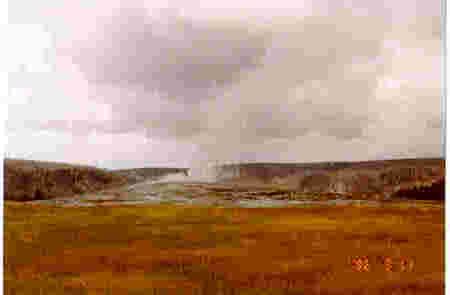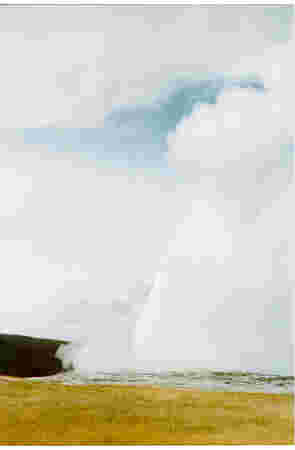Old Faithful
We visit the most famous geyser
in the world and a few of its brethren.
Probably the most famous feature
- natural or otherwise - in Yellowstone is Old Faithful. Old Faithful is
a geothermal geyser  that
erupts periodically. Right now, the period is about 70 minutes. I say "about"
because the period is not precise - you couldn't set your clock by it.
Sometimes it is less than 50 minutes, sometimes it is more than 80 minutes;
but, on the average, it fires off every 70 minutes, now. The Park Service
has been tracking the eruptions and the period is getting longer. It used
to be less than 40 minutes. Geysers are formed when water comes in contact
with magma in areas of volcanic activity. There are no active volcanos
in Yellowstone, but there are some inactive volcanos. Note the difference
between an inactive volcano and an extinct volcano. Mt. St. Helens was
an inactive volcano (its now active). Inactive volcanos are dormant, extinct
volcanos are dead. I am from Reno, Nevada, and we have an inactive volcano
- Mt. Rose. At the base of Mt. Rose there is a geothermal area called Steamboat.
There are old pictures of this geothermal area that show geysers that were
more spectacular than Old Faithful. However, Steamboat was not protected
by a national park and was developed first as a spa and now as geothermal
electrical power plant fields. Steamboat's geysers are gone, but the fissures
in the ground are still there to see and you can hear the boiling water
in them. So, to see a geyser, we had to go to Yellowstone.
that
erupts periodically. Right now, the period is about 70 minutes. I say "about"
because the period is not precise - you couldn't set your clock by it.
Sometimes it is less than 50 minutes, sometimes it is more than 80 minutes;
but, on the average, it fires off every 70 minutes, now. The Park Service
has been tracking the eruptions and the period is getting longer. It used
to be less than 40 minutes. Geysers are formed when water comes in contact
with magma in areas of volcanic activity. There are no active volcanos
in Yellowstone, but there are some inactive volcanos. Note the difference
between an inactive volcano and an extinct volcano. Mt. St. Helens was
an inactive volcano (its now active). Inactive volcanos are dormant, extinct
volcanos are dead. I am from Reno, Nevada, and we have an inactive volcano
- Mt. Rose. At the base of Mt. Rose there is a geothermal area called Steamboat.
There are old pictures of this geothermal area that show geysers that were
more spectacular than Old Faithful. However, Steamboat was not protected
by a national park and was developed first as a spa and now as geothermal
electrical power plant fields. Steamboat's geysers are gone, but the fissures
in the ground are still there to see and you can hear the boiling water
in them. So, to see a geyser, we had to go to Yellowstone.
Old Faithful does not just turn
on instantly. Its sits there and steams all the time. When it gets ready
to erupt, it starts gurgling  and
a small fountain appears. Over about 3 to 5 minutes, the fountain builds
until it is over 100 feet high! Of course, the gurgling turns into a loud
hissing noise and the tourists all start with the "Ooos" and "Ahs". For
the first eruption when we were there, the experience was ruined by a construction
crew running air compressors and power saws while rebuilding the boardwalk
around the geothermal area. Oh, yes, there are boardwalk paths running
through all the geothermal areas in Yellowstone. So you say, "Hey! You
mean I can't walk on the ground in geothermal areas and get my tootsies
warm?" Don't be disappointed! the boardwalks let you get up close to the
geothermal features. If there were no boardwalks and you tried to walk
across the geothermal fields, there are areas where there is only a thin
crust on top of a boiling pool of water. Step on that and your tootsies
would be really warm! Also, some of the geothermal areas are active, meaning
that new boiling pools are constantly forming under crusts.
and
a small fountain appears. Over about 3 to 5 minutes, the fountain builds
until it is over 100 feet high! Of course, the gurgling turns into a loud
hissing noise and the tourists all start with the "Ooos" and "Ahs". For
the first eruption when we were there, the experience was ruined by a construction
crew running air compressors and power saws while rebuilding the boardwalk
around the geothermal area. Oh, yes, there are boardwalk paths running
through all the geothermal areas in Yellowstone. So you say, "Hey! You
mean I can't walk on the ground in geothermal areas and get my tootsies
warm?" Don't be disappointed! the boardwalks let you get up close to the
geothermal features. If there were no boardwalks and you tried to walk
across the geothermal fields, there are areas where there is only a thin
crust on top of a boiling pool of water. Step on that and your tootsies
would be really warm! Also, some of the geothermal areas are active, meaning
that new boiling pools are constantly forming under crusts.
So what causes periodic geysers
like Old Faithful? One theory is that the vent from the boiling subterranean
water reservoir is plugged by a large boulder. As the water boils, the
steam pressure builds up until it moves the boulder and the steam can escape
to the surface, relieving the pressure, which lets the boulder drop back
down and plug the hole, starting the cycle all over again. As the vent
and the boulder become eroded by the steam over the years, leakage occurs
and it takes longer to build up pressure. Also, the pressure does not build
up as much; so the height of the eruption decreases. Yes, this means that,
someday Old Faithful will cease to erupt. The Park Service does not know
when the death of Old Faithful will occur. It could be tomorrow! So, you
had better get your vacation plans in order and visit Yellowstone soon!

High
resolution (148K) beginning of eruption
High
resolution (119K) buildup of eruption
High
resolution (104K) almost at peak eruption
High
resolution (96K) peak eruption
Return to Yellowstone
Vacation
Last Updated 4 July 2004 by Art O'Connor
 that
erupts periodically. Right now, the period is about 70 minutes. I say "about"
because the period is not precise - you couldn't set your clock by it.
Sometimes it is less than 50 minutes, sometimes it is more than 80 minutes;
but, on the average, it fires off every 70 minutes, now. The Park Service
has been tracking the eruptions and the period is getting longer. It used
to be less than 40 minutes. Geysers are formed when water comes in contact
with magma in areas of volcanic activity. There are no active volcanos
in Yellowstone, but there are some inactive volcanos. Note the difference
between an inactive volcano and an extinct volcano. Mt. St. Helens was
an inactive volcano (its now active). Inactive volcanos are dormant, extinct
volcanos are dead. I am from Reno, Nevada, and we have an inactive volcano
- Mt. Rose. At the base of Mt. Rose there is a geothermal area called Steamboat.
There are old pictures of this geothermal area that show geysers that were
more spectacular than Old Faithful. However, Steamboat was not protected
by a national park and was developed first as a spa and now as geothermal
electrical power plant fields. Steamboat's geysers are gone, but the fissures
in the ground are still there to see and you can hear the boiling water
in them. So, to see a geyser, we had to go to Yellowstone.
that
erupts periodically. Right now, the period is about 70 minutes. I say "about"
because the period is not precise - you couldn't set your clock by it.
Sometimes it is less than 50 minutes, sometimes it is more than 80 minutes;
but, on the average, it fires off every 70 minutes, now. The Park Service
has been tracking the eruptions and the period is getting longer. It used
to be less than 40 minutes. Geysers are formed when water comes in contact
with magma in areas of volcanic activity. There are no active volcanos
in Yellowstone, but there are some inactive volcanos. Note the difference
between an inactive volcano and an extinct volcano. Mt. St. Helens was
an inactive volcano (its now active). Inactive volcanos are dormant, extinct
volcanos are dead. I am from Reno, Nevada, and we have an inactive volcano
- Mt. Rose. At the base of Mt. Rose there is a geothermal area called Steamboat.
There are old pictures of this geothermal area that show geysers that were
more spectacular than Old Faithful. However, Steamboat was not protected
by a national park and was developed first as a spa and now as geothermal
electrical power plant fields. Steamboat's geysers are gone, but the fissures
in the ground are still there to see and you can hear the boiling water
in them. So, to see a geyser, we had to go to Yellowstone.
 and
a small fountain appears. Over about 3 to 5 minutes, the fountain builds
until it is over 100 feet high! Of course, the gurgling turns into a loud
hissing noise and the tourists all start with the "Ooos" and "Ahs". For
the first eruption when we were there, the experience was ruined by a construction
crew running air compressors and power saws while rebuilding the boardwalk
around the geothermal area. Oh, yes, there are boardwalk paths running
through all the geothermal areas in Yellowstone. So you say, "Hey! You
mean I can't walk on the ground in geothermal areas and get my tootsies
warm?" Don't be disappointed! the boardwalks let you get up close to the
geothermal features. If there were no boardwalks and you tried to walk
across the geothermal fields, there are areas where there is only a thin
crust on top of a boiling pool of water. Step on that and your tootsies
would be really warm! Also, some of the geothermal areas are active, meaning
that new boiling pools are constantly forming under crusts.
and
a small fountain appears. Over about 3 to 5 minutes, the fountain builds
until it is over 100 feet high! Of course, the gurgling turns into a loud
hissing noise and the tourists all start with the "Ooos" and "Ahs". For
the first eruption when we were there, the experience was ruined by a construction
crew running air compressors and power saws while rebuilding the boardwalk
around the geothermal area. Oh, yes, there are boardwalk paths running
through all the geothermal areas in Yellowstone. So you say, "Hey! You
mean I can't walk on the ground in geothermal areas and get my tootsies
warm?" Don't be disappointed! the boardwalks let you get up close to the
geothermal features. If there were no boardwalks and you tried to walk
across the geothermal fields, there are areas where there is only a thin
crust on top of a boiling pool of water. Step on that and your tootsies
would be really warm! Also, some of the geothermal areas are active, meaning
that new boiling pools are constantly forming under crusts.
